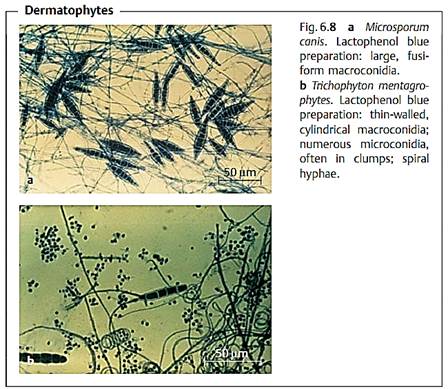


 النبات
النبات
 الحيوان
الحيوان
 الأحياء المجهرية
الأحياء المجهرية
 علم الأمراض
علم الأمراض
 التقانة الإحيائية
التقانة الإحيائية
 التقنية الحيوية المكروبية
التقنية الحيوية المكروبية
 التقنية الحياتية النانوية
التقنية الحياتية النانوية
 علم الأجنة
علم الأجنة
 الأحياء الجزيئي
الأحياء الجزيئي
 علم وظائف الأعضاء
علم وظائف الأعضاء
 الغدد
الغدد
 المضادات الحيوية
المضادات الحيوية|
Read More
Date: 22-3-2016
Date: 30-10-2015
Date: 17-11-2015
|
Cutaneous Mycoses
Dermatophytes (Dermatomycoses or Dermatophytoses)
Dermatophytes are fungi that infect tissues containing plenty of keratin (skin, hair, nails).
Classification. Dermatophytes are classified in three genera: Trichophyton (with the important species T. mentagrophytes, T. rubrum, T. schoenleinii, T. tonsurans); Microsporum (M. audouinii, M. canis, M. gypseum); and Epidermophyton (E.floccosum). Some dermatophyte species are anthropophilic, others zoophilic. The natural habitat of the geophilic species M. gypseum is the soil.
Morphology and culture. The dermatophytes are filamentous fungi. They grow readily on fungal nutrient mediums at 25-30 °C. After 5-14 days, cultures with a woolly appearance, in different colors, usually develop (Fig. 6.8).
Pathogenesis and clinical pictures. Dermatomycoses are infections that are transmitted directly by human contact, animal-human contact or indirectly on inanimate objects (clothes, carpets, moisture, and dust in showers, swimming pools, wardrobes, gyms). The localization of the primary foci corresponds to the contact site. Thus feet, uncovered skin (hair, head, facial skin) are affected most frequently. Different species can cause the same clinical picture. Frequent dermatomycoses include:

-Tinea corporis (ringworm): Microsporum canis and Trichophyton mentagrophytes. Affects hairless skin.
-Tinea pedis (athlete's foot): T. rubrum, T. mentagrophytes, and Epidermophyton floccosum. Affects mainly the lower legs.
-Tinea capitis: T. tonsurans and M. canis. Affects scalp hair.
-Tinea barbae: T. rubrum and T. mentagrophytes. Beard ringworm.
-Tinea unguium: T. rubrum, T. mentagrophytes, and E. floccosum.
-Onychomycosis (nail mycosis): Various dermatophytes and Candida spp.
Diagnosis. Material suitable for diagnostic analysis include skin and nails scrapings and infected hair. The fungi are observed under the microscope in a KOH preparation. Identification is based on the morphology of the hyphae as well as on the macroconidia and microconidia in the fungal cultures.
Therapy. Dermatomycoses can be treated with locally applied antimycotic agents. In cases of massive infections of the hair, and above all of the nails, the oral allylamine terbinafine or azoles can be used. Griseofulvin is rarely used today.
Epidemiology and prevention. Dermatophytes occur naturally all over the world. The geophilic dermatophyte, M. gypseum, can cause infections in persons in constant, intensive contact with the soil (e.g., gardeners). Prophylactic measures for all dermatomycoses consist in avoiding direct contact with the pathogen. Regular disinfection of showers and wardrobes can contribute to prevention of athlete's foot, a very frequent infection.
Other Cutaneous Mycoses
Pityriasis (or tinea) versicolor is a surface infection of the skin caused by Malassezia furfur. This infection is observed mainly in the tropics but is known all over the world. It causes hypopigmentations. M. furfur is dependent for its metabolic needs on a source of long-chain fatty acids. This fungus is actually a component of the skin's normal flora. The pathogenesis of the infections has not yet been clarified.
Tinea nigra, which occurs mainly in the tropics, is caused by Exophiala werneckii. Infection results in brown to black, maculous efflorescences on the skin.
White and black piedras is an infection of the hair caused by Trichosporon beigelii or Piedraia hortae.
References
Kayser, F. H. (2005). Medical Microbiology. Thieme Stuttgart. New York.



|
|
|
|
التوتر والسرطان.. علماء يحذرون من "صلة خطيرة"
|
|
|
|
|
|
|
مرآة السيارة: مدى دقة عكسها للصورة الصحيحة
|
|
|
|
|
|
|
نحو شراكة وطنية متكاملة.. الأمين العام للعتبة الحسينية يبحث مع وكيل وزارة الخارجية آفاق التعاون المؤسسي
|
|
|